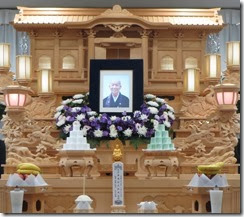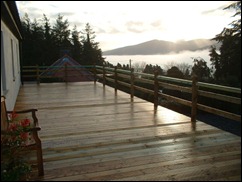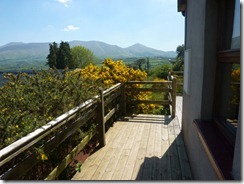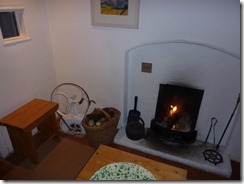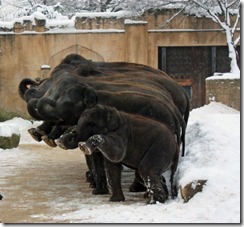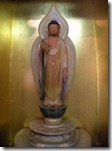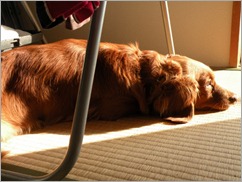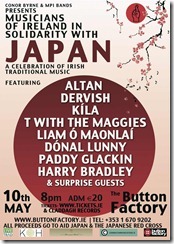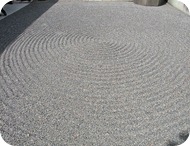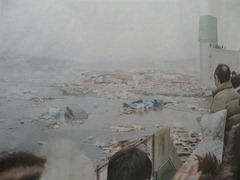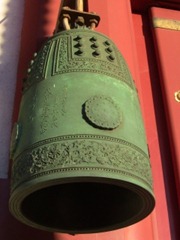This is a short interview with the late Gudo Nishijima Roshi (1919 - 2014), my Buddhist teacher, in which he talks about his idea about practicing zazen (meditation) everyday in daily life, and some other topics. The video runs for about 6 minutes. Thanks to Ingrid for the video.
Wednesday, February 25, 2015
Gudo Nishijima Sensei Interview - Sept 2008
This is a short interview with the late Gudo Nishijima Roshi (1919 - 2014), my Buddhist teacher, in which he talks about his idea about practicing zazen (meditation) everyday in daily life, and some other topics. The video runs for about 6 minutes. Thanks to Ingrid for the video.
Saturday, July 26, 2014
Zen Meditation Retreat at Jampa Ling Centre in County Cavan - August 1 to 3, 2014
We'll be holding a Zen meditation retreat at the Jampa Ling Buddhist Centre near Bawnboy village in County Cavan over the weekend of August 1-3. The retreat is suitable for anyone interested in Buddhism and/or meditation, and beginners are welcome.
The retreat will run from Friday evening until Sunday afternoon.  At the retreat we'll be practicing sitting and walking meditation, and will hold some talks and discussions on Buddhism as well as some periods of light work in the gardens and around the Centre. There will also be free time for walks through the woodland and surrounding area, and to visit the Centre's beautiful walled garden. All meals during the retreat are based on a vegetarian menu.
At the retreat we'll be practicing sitting and walking meditation, and will hold some talks and discussions on Buddhism as well as some periods of light work in the gardens and around the Centre. There will also be free time for walks through the woodland and surrounding area, and to visit the Centre's beautiful walled garden. All meals during the retreat are based on a vegetarian menu.
The cost for the retreat is 80 euros. You can email me at tokyozazen@gmail.com to register. The closing date for registration is Monday, July 28.
Email me for more information or check my webpage at www.zen.ie/cavanretreat.html.
Thursday, March 6, 2014
Couple of essays for the present moment
A friend of mine has written a couple of essays relating to the present moment for a magazine called “Culture Counter”. The first one is called “Phenomenological eco-mysticism”, which is about some experiences he had in the US and Japan recently. The second one is called “Overcoming the cult of the present moment”, which compares what is sometimes meant when people talk about being here and now, and something the Buddhist monk Dogen wrote about the present moment in his book Shobogenzo.
Tuesday, February 4, 2014
Master Gudo Nishijima’s Wake
My Buddhist teacher, Master Gudo Wafu Nishijima passed away on January 28 at the age of 94. I attended his wake tonight in snowy Tokyo. It was a very nice service with his family and friends and many of his students in attendance. We chanted Buddhist sutras and offered incense, and remembered his great life and kindness to us all. The photo above is of the altar with Master Nishijima’s framed picture.
Sensei, thank you for all your kindness and help, and please rest in peace.
Thursday, May 23, 2013
Tokyo Meditation Class on May 25
I’ll be holding a Zazen meditation class in Tokyo this coming Saturday, May 25. Anyone interested is welcome to attend, and attendance is free. The first part of the class will be from 11 am to 12 noon, and the second part will be from 12.30 to 2 pm. You’re welcome to come to both the morning and afternoon parts, or to either one. The schedule is:
11.00 – 11.25 Zazen
11.25 – 11.35 Kinhin (this is a slow walking practice)
11.35 – 12.00 Zazen
12.00 – 12.30 Break (for lunch or a rest)
12.30 – 1.00 Zazen
1.00 – 2.00 Talk (optional)
If it’s your first time to do Zazen and you’d like some instructions, please come about 10 or 15 minutes before the start and I’ll show you what to do.
The class will be held at Tokyo University’s Young Buddhists Association. You can click here to download a map with directions to the Young Buddhists Association from the Marunouchi and Oedo subway lines. Both lines run through Shinjuku station. The stop on both lines is called "Hongo-Sanchome".
If you’re coming from Hongo-sanchome station on the Marunouchi line, turn right after passing through the ticket barrier and follow the alley out to the main street. The building where the meetings are held is across the street. You can cross at the traffic lights on the corner (see map). If you’re coming from Hongo-sanchome station on the Oedo line, take exit no. 5 and turn to the left after leaving the station. Follow the main street and then turn left again at the corner with the traffic lights (see map).
The entrance to the Young Buddhists Association is next to the Nicos travel agency (directly behind the bus stop). You'll see a "Zazen Practice" sign on the glass door at the entrance.
Here's a video showing how to get to the meetings from Hongo-sanchome station on the Marunouchi line.
Email me if you need more information, otherwise feel free to come along on the day and give it a try.
Sunday, September 30, 2012
Retreat in Cavan
We held a retreat last month at the Jampa Ling
 Buddhist Centre in Bawnboy in County Cavan. It was our first time to hold a Zen retreat there, and I wasn’t quite sure what to expect. But it turned out to be a real nice retreat with a real nice group of people. Some people were trying a Buddhist retreat and meditation for the first time, while other people had been at a retreat before and had been doing meditation for several years or more. The people who were trying it for the first time seemed to enjoy it overall, and no-one complained about sore legs or the bad jokes. The people who had been to retreats before seemed to enjoy the atmosphere and zazen at Jampa Ling as well. During the retreat we got a chance to meet the Tibetan monk who lives at the Jampa Ling Centre and some of his students. It was my first time to meet a Tibetan Buddhist teacher. After chatting to him and his students, I realized that even though there are differences between Zen Buddhism and Tibetan Buddhism, there’s plenty of common ground as well.
Buddhist Centre in Bawnboy in County Cavan. It was our first time to hold a Zen retreat there, and I wasn’t quite sure what to expect. But it turned out to be a real nice retreat with a real nice group of people. Some people were trying a Buddhist retreat and meditation for the first time, while other people had been at a retreat before and had been doing meditation for several years or more. The people who were trying it for the first time seemed to enjoy it overall, and no-one complained about sore legs or the bad jokes. The people who had been to retreats before seemed to enjoy the atmosphere and zazen at Jampa Ling as well. During the retreat we got a chance to meet the Tibetan monk who lives at the Jampa Ling Centre and some of his students. It was my first time to meet a Tibetan Buddhist teacher. After chatting to him and his students, I realized that even though there are differences between Zen Buddhism and Tibetan Buddhism, there’s plenty of common ground as well.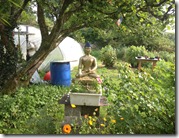 Apart from meditation, one of the activities during the retreat was a work period each morning for about 40 minutes. During the work period we chopped veggies or worked in the garden or cleaned up around the Centre. I was in the garden crew for both days. Usually I work indoors, so it was great to get outside in the fine weather and do some weeding and mess around with the wheel-barrow, although the bit of weeding I did was nothing compared to some of the work that was done by other people in the gardening crew. The person in charge of the gardens at Jampa Ling told me afterwards he was delighted to get so much help. He didn’t expect people would get into it so much, and he told me to let everyone know they were welcome back anytime! I didn’t get a chance to chop any veggies during the retreat, but I appreciated all the work people did to help with the food prep and wash-up during the retreat.
Apart from meditation, one of the activities during the retreat was a work period each morning for about 40 minutes. During the work period we chopped veggies or worked in the garden or cleaned up around the Centre. I was in the garden crew for both days. Usually I work indoors, so it was great to get outside in the fine weather and do some weeding and mess around with the wheel-barrow, although the bit of weeding I did was nothing compared to some of the work that was done by other people in the gardening crew. The person in charge of the gardens at Jampa Ling told me afterwards he was delighted to get so much help. He didn’t expect people would get into it so much, and he told me to let everyone know they were welcome back anytime! I didn’t get a chance to chop any veggies during the retreat, but I appreciated all the work people did to help with the food prep and wash-up during the retreat. The Jampa Ling Centre is in a great location surrounded by woodland
 and lakes. In one of the free periods during the retreat a few of us walked up to the nearby lake for a swim. I hadn’t brought my swimming togs so I just went in for a paddle, but the wise folks who had brought their swim gear really enjoyed the water. To get to the lake we had to walk through a field that had some cows and a bull. I grew up in the countryside and I’ve come across the odd bull that’d get very upset if you approached his field on the wrong day, so I was a bit worried when someone told me there was actually a bull there as we were walking through the field. I had visions of us being chased and attacked by the bull, and then having to cancel the retreat and it being all my fault. Luckily though, the bull must have picked up on the fact that the retreat was strictly vegetarian, and he and his herd let us pass in what I interpreted as a kind of mutual understanding of live and let live.
and lakes. In one of the free periods during the retreat a few of us walked up to the nearby lake for a swim. I hadn’t brought my swimming togs so I just went in for a paddle, but the wise folks who had brought their swim gear really enjoyed the water. To get to the lake we had to walk through a field that had some cows and a bull. I grew up in the countryside and I’ve come across the odd bull that’d get very upset if you approached his field on the wrong day, so I was a bit worried when someone told me there was actually a bull there as we were walking through the field. I had visions of us being chased and attacked by the bull, and then having to cancel the retreat and it being all my fault. Luckily though, the bull must have picked up on the fact that the retreat was strictly vegetarian, and he and his herd let us pass in what I interpreted as a kind of mutual understanding of live and let live. There were really friendly dogs and other animals around Jampa Ling as well. One of the dogs was the cute scotch terrier in the photo, and another was a very friendly border collie who was one of those dogs that loves to run after sticks and bring it back for you to throw again. If he saw you walking around, he’d run off and get a stick and bring it over and drop it down a few feet in front of you. Then he’d back off a few yards and crouch down and wait for you to throw it so he could run after it and bring it back to repeat the process over and over. If you walked past the stick without throwing it, he’d get it and drop it down in front of you again, and would keep doing that until you either gave in or went somewhere he couldn’t find you. Well he got plenty of throws out of me and lots of other people during the retreat. I’m sure he must have thought it was great to have the Zen folks around for the few days as well.
There were really friendly dogs and other animals around Jampa Ling as well. One of the dogs was the cute scotch terrier in the photo, and another was a very friendly border collie who was one of those dogs that loves to run after sticks and bring it back for you to throw again. If he saw you walking around, he’d run off and get a stick and bring it over and drop it down a few feet in front of you. Then he’d back off a few yards and crouch down and wait for you to throw it so he could run after it and bring it back to repeat the process over and over. If you walked past the stick without throwing it, he’d get it and drop it down in front of you again, and would keep doing that until you either gave in or went somewhere he couldn’t find you. Well he got plenty of throws out of me and lots of other people during the retreat. I’m sure he must have thought it was great to have the Zen folks around for the few days as well. Anyway, I’d like to thank everyone who came to the retreat, as well as those who wanted to come but couldn’t make it this time. I know quite a people travelled a long distance to be there. Thanks also to everyone at Jampa Ling who made us feel so welcome. Hopefully, we’ll be able to organize another retreat there at some point.

(Ps. Many thanks to Michael for the photos.)
Monday, May 21, 2012
The Sun is Eclipsed by the Moon
The first album I ever bought was a cassette tape of Pink Floyd’s “Dark Side of the Moon”. That was back in the days before CDs and MP3. My brother had borrowed the album from one of his mates, and he played it constantly on our old record player for a week or two. We had no headphones in our house, so we all ended up listening to whatever was been played. It took me a while to get into it, but after listening to it for a couple of weeks like that I was a fan. But then he had to give his buddy back the album. So we had no Pink Floyd anymore. I was only around 13 or so at the time, and never had much money, but I decided to save up the little bits of cash I got from my parents for a few weeks and invest in the Pink Floyd. So after saving up for a wee bit, I went into our local music shop and bought my first ever album. I kept it for a long time and played it over and over. Later on, I didn’t play it so much and got into other sounds, but every once in a while I’d take out the Dark Side album and it always sounded as good as ever.
On one of the tracks, they sing about “the sun is eclipsed by the moon”. I never really gave much thought to what they were referring to until the last few days. What got me thinking about it today was that we had a solar eclipse here on our own doorstep in Japan. It started at about 6 am and continued for a few hours. We bought some special glasses to use to look at the eclipse with. The ones we bought cost about 800 yen (7 or 8 euros), which I thought was going to be a waste of money, but they worked out well. They’re made with special material to filter out lots of different rays so you can see the eclipse clearly.
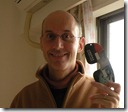 I figured we probably wouldn’t see much even with the glasses, but I was wrong. They made a big difference, and we could see the kind of silver circle around the moon just like you see in the photos. It was really, really cool, and way better than I imagined. Me and my son were awestruck for a couple of minutes when we looking at the perfect circle part.
I figured we probably wouldn’t see much even with the glasses, but I was wrong. They made a big difference, and we could see the kind of silver circle around the moon just like you see in the photos. It was really, really cool, and way better than I imagined. Me and my son were awestruck for a couple of minutes when we looking at the perfect circle part.
You should be able to see the eclipse in some places on the west coast of the US today and later on this year in Australia and New Zealand. If you’re in one of those spots, I’d recommend getting a pair of those glasses if you can. They make a big difference. The Japanese government were warning people not to look at the eclipse with the naked eye, because it might cause eye damage or make you feel sick for a while. I’m not sure how true that is, but apart from that, you may not see very much without them. It might look something like this photo:
The next solar eclipse we’ll be able to see in this part of the world won’t be for another 390 years or so. I’m not sure if my blog will still be around then, but in case it is, I’d just like to say for anyone reading this in 2402 that it was pretty cool way back here in 2012 too.
I wasn’t going to mention anything about Buddhism in this post, but when I was looking at the silver ring around the moon it reminded me of something we were reading in our zazen class the other day. We were going through a text Dogen wrote about the Lotus Sutra. One of the things that comes up in that is about how the Buddha was supposed to have a circle of white hair on his forehead that light shone out from. Supposedly white light from the circle of hair could reach up to a kind of Buddhist heaven or something like that. To me, those kinds of descriptions are mainly legends and are a kind of a romantic and poetic way of describing the Buddha. So when I read that sort of stuff, I usually don’t take it literally. But that was one thing I was reminded of this morning when I was looking at the silver ring in the sky. And in other texts in Buddhism they say that the whole universe is the Buddha’s body. It’s based on the Buddhist idea that everything in the universe is connected and is all part of one big whole thing, and you and me and everyone else are part of it too. So in that sense, I can see how the cool silver ring of light this morning might not be too unlike the idea of light radiating from the Buddha’s head.
By the way, one of my favorite tracks on the Dark Side album is “the Great Gig in the Sky”, which is something I feel like I got to experience today.
And one last thing, I realized afterwards that I had just seen the dark side of the moon for the first time with my very own eyes (with the help of those glasses). Wish you were here to see it too!

Thursday, December 15, 2011
Not a Long Way to Tipperary for the January Buddhist Retreat
My friend Harry Bradley is organizing a Zen Buddhist retreat next month in the lovely Glen of Aherlow in County Tipperary. The retreat will start at 7 pm on Friday 20th January and end at 5.30 pm on Sunday January 22nd.
The focus will be on zazen (seated meditation), kinhin (slow walking) and samu (work periods). There will be no chanting or formal ceremonies, although zendo etiquette will be observed (bowing on entering and leaving the zendo, bowing before and after sitting).
The retreat is suitable for anyone who’s already practicing meditation or who’s been to a Buddhist retreat before. There will be no official teacher there, but some of the people attending have a good bit of experience with meditation. There will be some themed discussions during the retreat as well.
The venue for the retreat is “Tigh Roy” in the picturesque Glen of Aherlow in Tipperary. The Glen of Aherlow sits between the Galtee mountains on one side and the Slievenamuck Ridge on the other, and has five spectacular lakes and some really breathtaking scenery. It should make a fine setting for the retreat. There’s more information about venue at http://www.tigroy.com/
The cost of the weekend, including all meals and accommodation, is €145 (per person sharing rooms with two single beds). Booking is essential as places are limited. A deposit of €45 will ensure a place on the retreat.
For more information or to book a place, email Harry at harrybradley@eircom.net.
You can follow some updates about the retreat at http://longriverzen.blogspot.com/
Monday, November 21, 2011
A Question of Existence and Time
Time and existence are as important for Buddhists as for anyone else. But the Buddhist idea about time and existence is different to most other ways of thinking about them. In general, we tend to think of time and existence as two separate things. I know I do anyway. Time is one thing, and existence or reality or whatever you like to call it is something else. The Buddhist idea isn’t like that though. Buddhism says that time and existence are two ways of talking about the same thing, they’re not separate from each other.
A while back, before he entered hospital, Gudo Nishijima sent me a copy of an email he wrote to someone who asked him about this.
The question was:
I read the chapter Uji (Existence and Time) in Master Dogen’s book Shobogenzo. In the chapter Master Dogen said:
''It is a complete realization that the whole of time is what the whole of existence is, and that there is nothing more than this''.
When he writes that, is he talking about the existence of a human being or about the existence of the Universe? If he’s referring to the whole existence of the Universe in that statement, it means that even the Universe is not limitless and consequently is dependent on time?
Gudo Nishijima’s answer was:
Master Dogen doesn’t say anything about the existence of a human being or the existence of the Universe in that statement. He says that existence and time are absolutely related with each other.
Master Dogen insists that without existence, time can not exist, and without time, existence can not exist at all. In other words, he insists that without existence, time never exists, and without time, existence never exists.
Therefore we should think that existence and time are very much related with each other. So it’s impossible to think about existence without thinking about time, and it’s impossible to think about time without thinking about existence.
Existence and time should be considered together, and it might not make sense to consider the question of existence and time without thinking about them like that.
Master Dogen clearly insists such opinion.
Gudo Wafu Nishijima
It’s only a small point in some ways, but that’s the Buddhist idea about existence and time. That’s why you sometimes hear people talking about “being here and now”. “Here” is the existence side, and “now” is the time side. And even though people use that phrase to describe feeling really present in the moment and focused on what’s happening right now and nothing else, actually the phrase “being here and now” applies to everyone. To you and me and all the folks in the neighborhood. And it’s like that right throughout our lives. There’s no other way. The only place we can ever be is where we are at each moment. So in a way it’s not a big deal. It’s the same for everyone.
What happens to most of us, though, is that our thoughts distract us from where we are and what we’re doing. So instead of focusing on slicing the veggies, we’re thinking about what happened a couple of weeks back when we saw those dancing elephants in Iceland. Or maybe we think about how great things would be if we could manage to get a nice job in London… We all know how it goes. We’re doing something that we’re not too excited about and our mind is drifting off somewhere else.
This is something you’ll notice if you do meditation. You’ll be sitting there on the cushion, and your mind will be going all over the place. That’s what happens to me anyway. When I do meditation, very little is happening outwardly, I’m literally just sitting there. But my mind can get really active imagining all sorts of different scenarios about different things or dreaming about all kinds of experiences that are never going to happen. But if you sit there for a while, gradually your mind starts to settle down all by itself, and during the meditation you can notice that, hey, you’re just sitting on the cushion doing your meditation. That’s basically “being here and now”. It’s not a big deal, and in a way it’s very simple, but it’s kind of a nice thing to notice too.
And when you get up off the cushion, that “being here and now” might stay with you for a while, and you might notice that being here and now isn’t so bad after all. The only thing about it is that even though people can write and talk about it, “being here and now” isn’t really something we can leave to our imagination. It’s something we have to experience for ourselves. That might sound difficult, because sometimes when we hear words like “being here and now”, it sounds like it must be something really intense that’s very faraway from where we are at the particular time. But actually it’s not like that. You’re already experiencing it. It’s just a matter of noticing, or maybe not noticing, it.
When I used to talk to Gudo Nishijima about this kind of thing, he used to say something like “we are enjoying the present moment”. It sounds really simple, and in many ways it is, but a lot of times we get dragged away by our thoughts of somewhere else or some other time and miss out on the things that are happening right in front of us. Doing meditation helps us to notice that.
So if you’re looking for a way to enjoy the present moment a bit more, you know what to do. And figuring out where and when to do it is easy too, right?
Monday, November 14, 2011
I Know a Way to Eliminate Suffering from Life
My friends Ingrid and Jiku-san came to Tokyo recently from Chile for a short visit. Ingrid is a student of Gudo Nishijima Roshi and Jiku-san is a student of a Japanese monk named Daisetsu Tangen Roshi. They both became interested in Zen Buddhism after they had been practicing yoga for a while.
Ingrid’s first experience with meditation was at a yoga class in Chile. After doing meditation there, she decided to try it at home, and continued to practice at home for 10 years. Later she began to practice with a small Buddhist group in Santiago. She came to Japan a few years later and met Nishijima Roshi in Tokyo. Afterwards, she started a Buddhist meditation group in Chile, and helped to organize Nishijima roshi’s visit for talks and retreats in Chile in 2004.
Jiku-san’s first name is Patricio, but people usually call him by his Buddhist name “Jiku-san”. He first encountered zazen when he was doing a yoga instructor’s course in Nepal. A few years later his job as a photographer brought him to Japan to do a feature on a Zen retreat at a temple named Bukkokuji. Bukkokuji is in a town called “Obama-shi” in Fukui prefecture. Daisetsu Tangen Roshi is the abbot there. When Jiku-san came to the temple, he liked the life there so much that he decided to stay. He eventually spent 10 years at Bukkokuji, before deciding to return to Chile to teach people about zazen and Buddhism. When he returned to Chile, he and Ingrid opened a Zazen dojo together and began to hold retreats and classes. Jiku-san also taught zazen at a prison there for 7 years. Recently, Ingrid and Jiku-san opened a new dojo called “El Zendo” in Chile. El Zendo is in a small town named Tunquen on the Pacific coast, about two hours from Santiago.
I asked Jiku-san and Ingrid to give a talk to our Saturday Zazen class while they were in Tokyo. They kindly agreed. Jiku-san told us about how he first became interested in Buddhism, and about life at Bukkokuji temple, including the daily schedule and going on begging rounds (called “takuhatsu”), and how the 10 years there changed his own life. He also told us about his experiences teaching Buddhism in Chile and at the Chilean prison, and about El Zendo. Ingrid told us about her experiences practicing at home on a daily basis for 10 years while raising her family, and how she ended up meeting Nishijima Roshi when she came to Tokyo, and later on began to practice together with Jiku-san in Chile.
I recorded the talk on my MP3 recorder. It lasts about 50 minutes. There’s also plenty of questions and answers during the talk. (The title of this post is something that comes up during the talk.) You can click here to download the MP3 file (47 MB).
By the way, one of the things that Jiku-san mentions during the talk is that people at the temple used to scrub themselves everyday with a “tawashi”. A tawashi is a small scrubbing brush that the Japanese usually use to scrub vegetables or pots and pans, but at the temple they found it was a good way to keep themselves clean too.
You can check out the El Zendo website at www.elzendo.cl. Jiku-san and Ingrid hold retreats there on a regular basis that everyone is welcome to attend. They told me sometimes people visit them from other countries in South America and from North America too.
Incidentally, the photo at the top of this post was taken the day we held the talk. Ingrid is in the center, and Jiku-san is on her right. The person on Jiku-san’s right is Harumi Saito. Harumi Saito began to practice zazen in the 1970’s with Nishijima Roshi at his Saturday classes in Tokyo, and has helped to organize the Tokyo classes for many years. He also taught zazen in a city near Tokyo for several years. He still comes to the Saturday zazen practice on a regular basis. On Ingrid’s left in the photo is Kimika, also one of Nishijima Roshi’s students. Kimika was one of the people who accompanied Nishijima Roshi on his visit to Chile in 2004. I’m the bald guy on Kimika’s left. (Thanks to Shinji for the photo.)
Friday, September 9, 2011
Zazen Practice in Tokyo
Just a note to say that our zazen class in Tokyo will be starting up again tomorrow after the summer break. The class is suitable for beginners, and anyone interested is welcome along.
The times are:
11.00 - 11.25 Zazen
11.25 - 11.35 Kinhin (slow walking meditation)
11.35 - 12.00 Zazen
12.00 - 12.30 Break (for lunch or a rest)
12.30 - 1.00 Zazen
1.00 - 2.00 Talk (optional)
Thursday, June 2, 2011
I Knew You Were Going To Ask That
Here’s a question someone asked me a while ago:
Do you have a sixth sense? How do you experience it?
Everybody has a sixth sense, except they don't notice most of the time. In Japan there's an expression "i-shin-den-shin" which means something like "heart-to-heart communication". Without saying anything you can sometimes pick up a vibe from someone else. Or it’s almost like we can communicate with someone even though they’re not anywhere near us. It's like if you stop off at the bakery on the way home from work and see a nice apple strudel and decide to buy it. But when you get home the person you live with has bought the exact same thing!
I watched a TV show recently about research someone did to see if a dog could tell when their owner was on the way home. It wasn’t to check if the dog had figured out the time the owner came home at each day. It was to see if the dog could tell if its owner was on the way home at a random time during a particular day. The dog lived in a house in a country town, and its owner spent most weekdays in a nearby city. The researcher arranged for the owner to come home from the city suddenly one afternoon, and recorded the dog’s behavior from around the time the owner started to make her way home. Sure enough, the dog started to become more alert right around the time the owner began to leave the city. By the time the owner got within a few miles of the house the dog was waiting right next to the door. It was strange to see, but the owner or the dog didn’t seem to care too much. They were just happy to see each other.
I’ve a feeling that if we worked on this we probably wouldn't need mobile phones anymore.
Or maybe it's just a coincidence...
Wednesday, May 4, 2011
Dublin Fundraising Concert For Japan
Here’s some information about a special fundraising concert being held in Dublin next week to aid the Japan disaster victims. Many of Ireland’s very best traditional musicians are taking part, and it sounds like it’s going to be a great night. It’s being held next Tuesday, May 10, at The Button Factory in Temple Bar. All proceeds go to aid Japan and the Japanese Red Cross.
Here’s what’s happening:
Traditional Music Legends to Show Solidarity with Japan
On Tuesday, 10th May, a host of traditional music legends will show their solidarity with the people of Japan by holding a special fundraising concert in The Button Factory, Dublin. T with the Maggies, Altan, Dervish, Liam Ó Maonlaí and Dónal Lunny will whip out the jigs, reels and beautiful ballads on the night in a celebration of traditional music.
The concert will be streamed live online so that people in Japan can see that Ireland is in solidarity with them. All the groups and musicians have a huge following in Japan where some fans are so dedicated to Irish traditional culture and music that they even learn to speak Gaeilge.
"All of us in the trad world wanted to do something after the years of support the Japanese have given to both Altan and the other bands. This is our small way of showing that they are in our thoughts. We guarantee a great night on May 10th and you can be sure that a few surprise guests will show up also!" said Mairéad Ní Mhaonaigh, Altan & T with the Maggies, who is co-organizing the concert.
"The concert is being co-organized with Chika Usami who is from Iwaki City, Fukushima, Japan but lives in Ireland. Chika said, “If I had been in Iwaki during the earthquake I would have been affected, my friends and family are still under threat from the nuclear power plant which is only 40km away, and I thought there must have been a reason for me to have been in Ireland. I wanted to do something to help Japan and tried to think what connected Ireland and Iwaki and I thought of Altan. They had performed in Iwaki in 2009 and I had met Altan after the concert and they invited me to come to Ireland sometime. Part of the reason I came to Ireland was because of how much I enjoy traditional Irish music and culture.”
ADM: €20 (Unreserved Limited Seating).
Advanced sales are available from www.tickets.ie or Claddagh Records, Cecilia Street, Temple Bar Tel:353 1 677 0262
Further Enquiries : www.buttonfactory.ie | TEL: +353 1 670 9202
Friday, April 22, 2011
3-day Zen Retreat in Golden Week
If you’ll be in Japan during golden week and wouldn’t mind spending a few days at a Zen temple in the countryside, you might be interested in a retreat we’ll be holding at Tokei-in temple in Shizuoka from April 30 to May 2. The retreat is suitable for beginners, and anyone interested is welcome along. There’s some more information about the retreat here.
Sunday, April 17, 2011
My Earthquake Experience
As everyone knows, we had a terrible earthquake and tsunami in Japan last month. Tens of thousands of people were killed, and hundreds of thousands were left without their homes and jobs and belongings. About 150,000 people are still living in temporary shelters at schools and other public buildings. Several towns and villages were completely destroyed. To make things even worse, the Fukushima nuclear power plant was severely damaged, and it’s been leaking radiation into the atmosphere for more than a month now. There have been lots of strong aftershocks since then too, and people are worried that there may be another big earthquake before long. So it’s been a horrible time for people in Japan. But despite it all many people are doing what they can to help each other, and are trying not to lose hope for the future.
I live in a place called Ibaraki Prefecture. It was one of the areas affected by the earthquake, although the damage here wasn’t as bad as in the worst affected areas further north. I’ve lived in Ibaraki for almost 20 years. We’ve had some strong earthquakes before now, but the earthquake in March was on a different scale to anything anyone here experienced before. Usually when an earthquake occurs, there’s a big kind of “thud” right at the start and then things start shaking and the vibrations gradually become stronger, and finally ease off after a minute or so. But when the earthquake struck on March 11 it was such a strong “thud” that it was clear from the start that it was a huge one. I was at home that day, and was doing some zazen on a cushion beside my desk when it struck. When the earthquake started, it was so strong that right away I jumped off the cushion and went under the desk. The walls in my room started shaking and all the things we had on shelves or in cupboards began to fall onto the floor. The shaking kept getting stronger and stronger, and everything was moving or falling down. The walls were moving back and forth and I thought the whole place was going to collapse.
After one or two minutes the shaking eventually started to ease off. I got out from under the desk to see if our place was okay. Some things had broken, but luckily there was no really serious damage. Our TV had fallen over, but it was still working. I turned it on to check the news. All the channels had emergency news about what was going on. The earthquake had destroyed buildings all over the north east of Japan, and the news was warning people about a large tsunami. The announcers were telling people to move away from the coast as quickly as they could. The channel I was watching was showing live pictures of the ocean that were being taken from a helicopter. It showed the tsunami approaching the coast and then moving inland through one town. A lot of people were trying to escape from the tsunami in their cars and on foot, but the tsunami was too big and moving too fast. There was nothing anyone could do to stop it. People were being swept away without any chance of escaping. It was very shocking to see what was happening. The tsunami moved inland for several kilometers and destroyed everything in its path. Then it went back to the ocean again. Almost nothing was left standing after it had gone.
Later on there were stories on the news about some people who managed to survive the tsunami. Even though they had survived, many of them had lost their parents, or spouse, or children in the tsunami. There were reports of how people tried to escape the tsunami by going to designated safe areas in their towns. The designated safe areas were meant to be safe places to go in the event of a tsunami, but the tsunami that day was so big that even those safe areas were washed away.
Over the next few days, we started to get more information about what had happened. Reports about the number of dead and missing kept increasing. Soon we heard that almost 10,000 people were missing in one town alone. Thousands of people had been buried under the debris left by the earthquake, and thousands more had been swept away by the tsunami. The rescue teams are still searching for missing people now, but many of them may never be found.
We also started to hear about a major problem at a nuclear power station in Fukushima. Fukushima is about 160 kilometers from where we live. The power station had been hit by the tsunami, and the reactors were damaged and radiation was escaping into the air and sea. The people living in towns nearby had to leave their homes and move to temporary shelters further away. Some of those people had lost family members and friends in the earthquake and tsunami, but were unable to return to their towns to search for them because of the radiation. The people who had to leave those towns may not be able to move back again until the radiation levels drop. No one knows how long that’s going to take, but it might be five or ten years or more.
There were a lot of problems in our own area for the first week or so after the earthquake. The water and gas supplies were cut off, and there was a shortage of gasoline because the gas stations had run out. Most of the shops were closed because they were damaged by the earthquake and it was unsafe to let people inside. The shops that were open soon ran out of food and water. It was difficult to buy any food for a few days, and there were huge queues even if you could find a shop that was open. The trains had stopped running too because of damage to the rails. There was an awful lot of concern about the radiation from the nuclear accident too. Nobody knew exactly what was going on, and whether it was safe to go outside or not. Some of our neighbors left the area because they were worried about how the radiation was affecting us.
But even though there was a certain amount of panic, most people were trying to stay calm and do what they could to get through it. People were sharing things and trying to help each other. After a week or so, things began to come back to normal in our area at least. The water and gas were gradually restored, and shops began to open again. The schools reopened as well after a few days. After another week or so the trains started running again and the gas stations opened too.
In some ways life is returning to normal in Japan now. But there’s an awful lot of recovery work to be done, and the Fukushima nuclear disaster is going to be with us for a long time. There is still a very deep sadness about what has happened, but it seems like the people who were directly affected by the disaster are taking each day as it comes, and trying to do what they can each day. The community spirit is very strong in Japan now too, and a lot of people are working together to help each other recover. Even the people in our neighborhood seem to be a lot closer and friendlier than before. I don’t know how long that’s going to last, but it seems like the disaster has changed the way a lot of people think about what’s important.
I like to think that Japan will recover from what’s happened, although it’s going to take a long time. Probably some things will return to something like the way they were before the disaster, but some things in Japan will never be the same.
Friday, December 3, 2010
Gudo Nishijima Roshi, 91

Gudo Nishijima turned 91 last Monday. To mark his birthday, we asked him to give a talk last Saturday at our zazen meeting at the Young Buddhists Association in Tokyo. We also invited him to a small birthday lunch afterwards at a nearby Indian restaurant.
I arranged to pick him up at his apartment on Saturday, and then take a taxi together to the place (called “Hongo-sanchome”) where we hold our zazen meeting. I called for him at about 11.30 am. He was still getting himself ready, and he asked me to wait for a few minutes while he finished getting ready. He offered me some fruit while I was waiting. He recommended the persimmons. He told me they that were really ripe and tasty now. He gave me one and a knife to cut it up with. He was right. The persimmon did taste great. When he saw I’d eaten it quickly, he offered me another one. I didn’t want to eat all his persimmons, so I said I was okay. I was hoping we’d have the chance to eat some lunch together before we went to the zazen meeting, but it was getting a bit late and Nishijima was worried about keeping the people at the meeting waiting. So we decided to skip lunch. Instead Nishijima brought a few bananas with us to eat in the taxi.
It took us a while to get a taxi after we left his apartment. Nishijima doesn’t walk so quickly nowadays, and I didn’t want to hurry him either. There were a lot of autumn leaves on the road as we were walking along. Nishijima told me the particular leaves that were on the path we were walking along are used as the symbol for Tokyo. The tree they’re from is called “ichou” in Japanese. In English it’s called the “ginkgo” tree.
When we reached the main road, we stood at the kerb and eventually hailed a passing taxi. Nishijima told the driver where we were going and a good way to get there. We chatted for a few minutes, and then he decided to eat some of the bananas. I was wondering if the taxi driver would object to us eating, but he didn’t seem to mind. Nishijima told me that a former prime minister of Japan, named Nakasone, used to keep some bananas in his office desk and whenever he was too busy to eat lunch, he’d eat the bananas instead. So Nishijima and myself were following prime minister Nakasone’s example with the bananas. Anyway, it was fun eating the bananas together in the back of the taxi. I think Nishijima enjoyed doing it like that.
We were late arriving at the meeting, and Nishijima felt bad that everyone had been waiting. But I think the people understood that Nishijima had made a big effort to get there, and they were happy to see him. The room we hold the talks in is on the second floor, and there’s a steep flight of steps to get there. Nishijima did his best to walk up, and me and Saito-san helped him along. He managed to climb the steps without too much trouble. Then he went into the room and started his talk.
He hadn’t given a talk in English for about a year, and he was a bit rusty at the start. But after a while he got into his stride, and spoke about how he got interested in Buddhism and Master Dogen. He also told us how he began giving lectures in the same building we were in about 50 years ago. He told us he first came across Master Dogen’s book Shobogenzo when he was 16 years old. He had a read a lot of books before then, and felt he could understand all the books that he had read. But when he read the Shobogenzo he couldn’t understand it all. Even though it was written in Japanese and he could understand the words, he just couldn’t understand the meaning of what Master Dogen had written in the Shobogenzo. He was very surprised that there was a book written in Japanese that he couldn’t understand. So he decided to try to find out what the meaning of the Shobogenzo was. He said he used to have a pocket edition of the Shobogenzo, which he carried around with him all the time. He said he read it on the train on his way to school and work and whenever else he had the chance. He read it over and over many times, and he eventually realized that the Shobogenzo was a very valuable and special book. He said he found that the Shobogenzo contained a real treasure. He said that what Master Dogen had written in the Shobogenzo was the “truth” itself. He said that even though he had read lots of books, he had never found one that he believed contained the truth. But after he’d read Shobogenzo over and over, he realized that he’d found a very special book. So he decided to devote his life to reading the Shobogenzo, and eventually he began translating it and giving lectures on it.
Nishijima told us that when he was 40 years old he asked the then head of the Young Buddhists Association at Tokyo University (the same place we were having the talk last Saturday) to allow him to hold a Buddhist meeting there. Nishijima’s idea was to hold a zazen class and afterwards give talks on the Shobogenzo. The head of the Young Buddhists Association agreed to Nishijima’s proposal, but told Nishijima that the Association wouldn’t be able to pay him any money for holding his lectures. Nishijima said he didn’t mind that, and he was happy to hold his classes for free. So he began to hold meetings there. Two Tokyo University students helped him organize the first few meetings and came to the zazen practice and his talk too. But then the students became busy with their other studies and couldn’t come to his class. The next time Nishijima held a class after that, no-one came to the zazen practice. But he decided to do zazen in the room by himself anyway. Just as he was finishing zazen, two people came in and asked him where the library was. He chatted to them for a few minutes and said that they could come and listen to his talk that day if they wanted, so he ended up giving a talk to the two people who came looking for the library. After that the number of people attending his talks started to increase. The following week he said five people came, and after that seven people attended. After a while 30 or 40 people were coming to his talks. Later on he started giving talks in English at the same place (which is how I met him). He told us he felt very happy that he was able to give a talk on the Shobogenzo to so many people there. He said he was really happy to see that the meetings (in Japanese and English) he started all those years ago were still continuing even now.
After he finished talking, we presented him with some flowers and a birthday card that everyone at the meeting had signed. His students in Finland had also sent him birthday greetings which they had all written. Some of his other students outside Japan had sent him a card or a gift as well.
After the meeting we took some photos with Nishijima Roshi, and then we went to a nearby Indian restaurant. The restaurant wasn’t that far away, and some people went by foot. But it was too far for Nishijima to walk to, so we went by taxi. While we were in the taxi Nishijima told me that he was very, very happy to be able to give a talk there that day. He said it was the happiest day of his life. He said he felt really happy that he had been able to give talks on Buddhism to people at the Young Buddhists Association.
It was around 3 pm when we reached the restaurant. There was 13 of us, and the restaurant put a few tables together to accommodate us. Nishijima sat in the middle and told us about the time he visited India and some other stories. He also answered some questions we had about Buddhism. At the end of the meal, we all stood up and sang “Happy Birthday”. Just about everyone who was in the restaurant joined in. I even heard the cooks joining in in the kitchen. After we finished singing, Nishijima said it was the happiest day of his life.
It was a real pleasure for me to spend time with Gudo Nishijima that day. It’s a day I’ll always remember.



